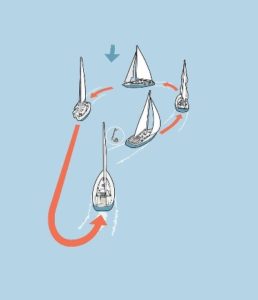Sailing in winter has a few differences to summer sailing:
Thermal conditions – Generally the air temperature is lower, so rain, showers or drizzle have a greater impact on comfort; Layering up is really important in winter sailing.
Man-Over-Boards (MOB) are pretty rare in Couta boats and we wear PFDs at all times so these are not as inherently dangerous as are commonly encountered by the general boating population, though there are a few qualifications to that.
Each boat needs to know the plan for a MOB. The Racing Rules of Sailing and our Sailing Instructions help with preparing the plan.
Start your engine
Rule 42.3 (g) Propulsion allows “Any means of propulsion may be used to help a person or vessel in danger”. In accordance with case 20, you don’t need to be sure a person is in danger; if you think they are, or they could be or could become in danger, then you are just about compelled to use the engine, as rule 1 states you “shall provide all possible help to any person or vessel in danger”
Call for more help
We have this rule in our Sailing Instructions to allow outside help as follows:
1.7 – Add to RRS 41: (e) help to recover from the water and return on board a crew member, provided the return on board is at the approximate location of the recovery.
This means a RIB can be radioed to pick up a MOB out of the water as quickly as possible to reduce risks. Often a Rib can do an easier recovery than getting directly back on a Couta boat or can be of key assistance if there are other complications with the Couta boat.
The water temperature in the bay is materially different in winter and can be below the cold water shock temperature of approx. 15 degrees Celsius. This difference means it is worth preparing for a possible MOB in winter. Here’s a summary of what your plan should consider:
MOB Plan
- Shout ‘man overboard’ / repeat to alert all the crew
- Throw a life buoy and/or dan buoy to the MOB
- Allocate a crewmember to point at the MOB in the water
- Slow the boat – heave to or head into the wind
- Start the motor
- Call on VHF to notify of a MOB
- Keep pointing; don’t lose sight of the MOB
- Prepare a throwing line
- The skipper will bring the boat alongside the MOB, with the boat pointing into the wind and the propeller stopped
- Get a line around the MOB and get them aboard.
The different MOB processes from the RYA can be found here http://www.rya.org.uk/knowledge-advice/cruising-tips/boat-handling-sail/Pages/man-overboard.aspx
What if you are the MOB?
Well the first big hurdle is “will your PFD inflate?” PFDs need to be serviced annually. You can service it yourself two out of every three years, and the third service needs to be by an authorised service agent for most brands.
It’s quite common to pray that a PFD will inflate when testing it in the water, instead of at the annual service intervals….
In winter you’re most likely to get a bit of a shock as to how much colder the water is than you are. You’re unlikely to get Hypothermia, but it’s important that you acknowledge the shock, inflate your PFD and get your breathing under control.
http://beyondcoldwaterbootcamp.com/4-phases-of-cold-water-immersion describes the processes of cold water immersion very well. Here’s a summary of what the first reactions will be.
Cold Shock Response lasts for only about a minute after entering the water and refers to the affect that cold water has on your breathing. Initially, there is an automatic gasp reflex in response to rapid skin cooling. If the head goes underwater, water may be breathed into the lungs during the gasp. The result is simple: drowning. That’s one of the many benefits of a life jacket or PFD: it helps to keep your head above water during this critical first response.
A second component of the Cold Shock Response involves hyperventilation. Like the gasp reflex, this is a natural reaction to the cold. Although this physiological response will subside, panic can cause a psychological continuance of hyperventilation. Prolonged hyperventilation can lead to fainting, so the key thing is to concentrate on controlling your breathing.
These are the most likely, though rare, issues when sailing in cold weather winter conditions but just like sailing in 40 degree heat and risking heat stroke, it’s all quite manageable with preparation.
Clothing:
Layer up with warm clothes
MOB:
- Have Lifejackets that will work
- Have a plan for the boat to call for help and return for a pick up
- Talk through the experience of MOB in colder water













